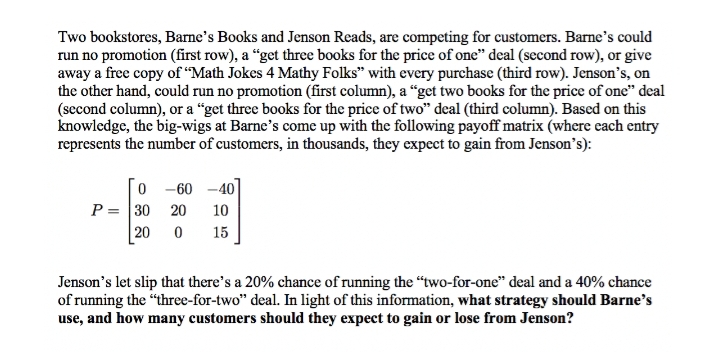Two bookstores, Barne's Books and Jenson Reads, are competing for customers. Barne's could run no promotion (first row), a "get three books for the price of one" deal (second row), or give away a free copy of "Math Jokes 4 Mathy Folks" with every purchase (third row). Jenson's, on the other hand, could run no promotion (first column), a "get two books for the price of one" deal (second column), or a "get three books for the price of two" deal (third column). Based on this knowledge, the big-wigs at Barne's come up with the following payoff matrix (where each entry represents the number of customers, in thousands, they expect to gain from Jenson's): 0-60-40 P = 30 20 10 20 0 15 Jenson's let slip that there's a 20% chance of running the "two-for-one" deal and a 40% chance of running the "three-for-two" deal. In light of this information, what strategy should Barne's
Two bookstores, Barne's Books and Jenson Reads, are competing for customers. Barne's could run no promotion (first row), a "get three books for the price of one" deal (second row), or give away a free copy of "Math Jokes 4 Mathy Folks" with every purchase (third row). Jenson's, on the other hand, could run no promotion (first column), a "get two books for the price of one" deal (second column), or a "get three books for the price of two" deal (third column). Based on this knowledge, the big-wigs at Barne's come up with the following payoff matrix (where each entry represents the number of customers, in thousands, they expect to gain from Jenson's): 0-60-40 P = 30 20 10 20 0 15 Jenson's let slip that there's a 20% chance of running the "two-for-one" deal and a 40% chance of running the "three-for-two" deal. In light of this information, what strategy should Barne's
Principles of Economics 2e
2nd Edition
ISBN:9781947172364
Author:Steven A. Greenlaw; David Shapiro
Publisher:Steven A. Greenlaw; David Shapiro
Chapter10: Monopolistic Competition And Oligopoly
Section: Chapter Questions
Problem 20P: May and Raj me the only two growers who provide organically grown corn to a local grocery store....
Related questions
Question

Transcribed Image Text:Two bookstores, Barne's Books and Jenson Reads, are competing for customers. Barne's could
run no promotion (first row), a "get three books for the price of one" deal (second row), or give
away a free copy of "Math Jokes 4 Mathy Folks" with every purchase (third row). Jenson's, on
the other hand, could run no promotion (first column), a "get two books for the price of one" deal
(second column), or a "get three books for the price of two" deal (third column). Based on this
knowledge, the big-wigs at Barne's come up with the following payoff matrix (where each entry
represents the number of customers, in thousands, they expect to gain from Jenson's):
0-60-40
P = 30 20 10
20 0 15
Jenson's let slip that there's a 20% chance of running the "two-for-one" deal and a 40% chance
of running the "three-for-two" deal. In light of this information, what strategy should Barne's
use, and how many customers should they expect to gain or lose from Jenson?
Expert Solution
This question has been solved!
Explore an expertly crafted, step-by-step solution for a thorough understanding of key concepts.
Step by step
Solved in 2 steps with 1 images

Knowledge Booster
Learn more about
Need a deep-dive on the concept behind this application? Look no further. Learn more about this topic, economics and related others by exploring similar questions and additional content below.Recommended textbooks for you

Principles of Economics 2e
Economics
ISBN:
9781947172364
Author:
Steven A. Greenlaw; David Shapiro
Publisher:
OpenStax

Managerial Economics: A Problem Solving Approach
Economics
ISBN:
9781337106665
Author:
Luke M. Froeb, Brian T. McCann, Michael R. Ward, Mike Shor
Publisher:
Cengage Learning

Principles of Economics 2e
Economics
ISBN:
9781947172364
Author:
Steven A. Greenlaw; David Shapiro
Publisher:
OpenStax

Managerial Economics: A Problem Solving Approach
Economics
ISBN:
9781337106665
Author:
Luke M. Froeb, Brian T. McCann, Michael R. Ward, Mike Shor
Publisher:
Cengage Learning